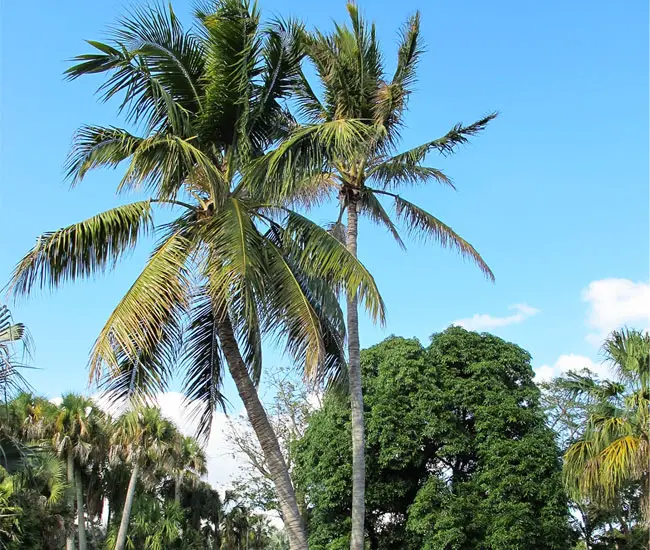
Whether you’re aiming to frame a view that would make even Mother Nature jealous or just want to carve out your own secret hideaway where nosy neighbors won’t intrude, get ready for a parade of palm options that will make your gardening heart sing!
Florida’s warm, tropical climate makes it one of the finest places in the world for cultivating palm trees.
If you’re fortunate enough to reside in a tropical climate like Florida, the palm tree choices for your garden are nearly unlimited. Palms, with their diverse range of colors, sizes, and shapes, are fantastic additions to any landscape.
Whether you’re looking to frame a picturesque view or create a private oasis away from curious eyes, the variety of palms available will astound you. They are an absolute must-have for anyone seeking to create a tropical garden paradise.
With an astonishing array of over 2,500 different species, it can be challenging to determine the ideal palm tree for your tropical garden.
So, to make it easier for you, here are the 10 most popular palm trees in Florida, listed by their common names. You should be able to find these palms at your local nursery.
1. Areca Palm
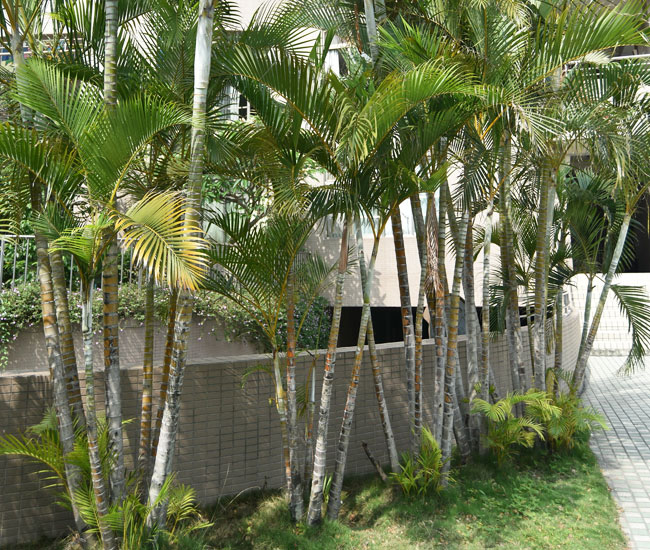
The Areca Palm, scientifically known as Chrysalidocarpus lutescens, presents as a luxuriant clustering palm reminiscent of bamboo. Comprising multiple slender, smooth trunks crowned with elegantly arching fronds, this palm species grows at a moderate pace, typically reaching a height of about 25 feet.
This palm boasts remarkable drought tolerance and heat resistance, making it a low-maintenance and fuss-free choice for plant enthusiasts. It thrives in well-drained, moist soil and appreciates a touch of partial shade.
Notably, its ability to thrive in low light conditions makes it an excellent indoor plant, with indoor specimens generally topping out at around 7 feet in height.
For those who prefer to cultivate this beauty outdoors, it flourishes in rich, slightly acidic soil. The Areca Palm is most effectively used as a privacy wall, in hedge plantings, as a prominent corner accent plant, as cover for a fence, or as a lush addition to blank walls, patios, screened lanais, or poolside containers.
This palm revels in warm weather and can tolerate cold temperatures down to approximately 30°F.
So, whether you’re looking to add a touch of tropical elegance indoors or enhance your outdoor landscaping with its graceful presence, the Areca Palm is a splendid choice.
2. Queen Palm
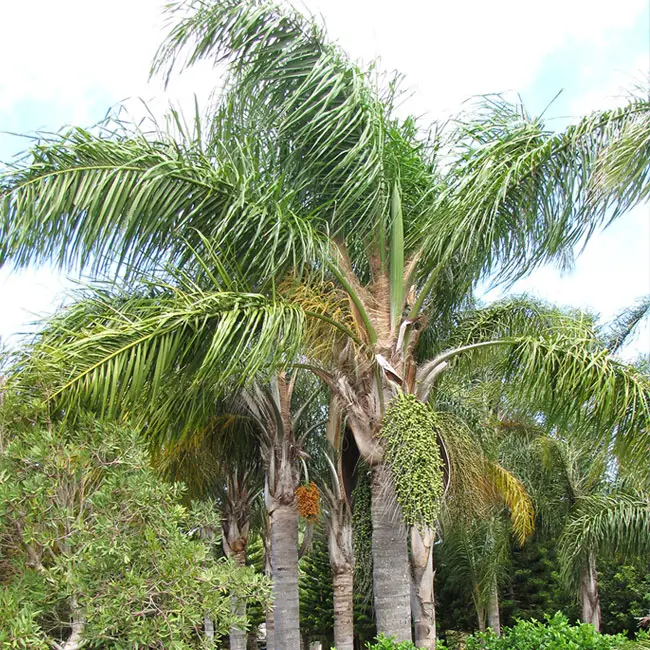
The Queen Palm, scientifically known as Syagrus romanzoffiana, stands out as one of the most beloved palm tree varieties in both Florida and California.
Garden enthusiasts cherish this palm for a variety of reasons, including its wide availability, rapid growth, cold resistance, low maintenance requirements, and its ability to add a tropical touch to any landscape.
Featuring a sleek, self-cleaning trunk and a lush crown of dark green, feathery leaves, the Queen Palm is not only visually appealing but also a speedy grower.
While it can potentially reach towering heights of up to 60 feet, it typically grows to a more manageable 30 feet.
Thanks to its impressive growth rate, you can start with an inexpensive seedling and, in just two years, watch it reach a height of 6 feet. If you’re eager to accelerate its growth, simply provide it with more water and fertilizer.
Like most palm species, the Queen Palm thrives in well-drained, moisture-rich soil. This resilient and adaptable palm can tolerate various soil types, from sandy to clayey.
Although conventional wisdom suggests that the Queen Palm can endure temperatures no lower than 25°F, it has been known to withstand even colder temperatures, dipping into the upper teens°F.
In landscaping, the Queen Palm finds its ideal placement as a natural fence or property line, along streets or driveways.
Its dense crown makes it perfect for providing shade around pool areas or as a striking backdrop for smaller palm species that prefer partial shade.
Whether you’re seeking an elegant boundary or a touch of the tropics, the Queen Palm is a fantastic choice for your landscape needs.
3. Foxtail Palm
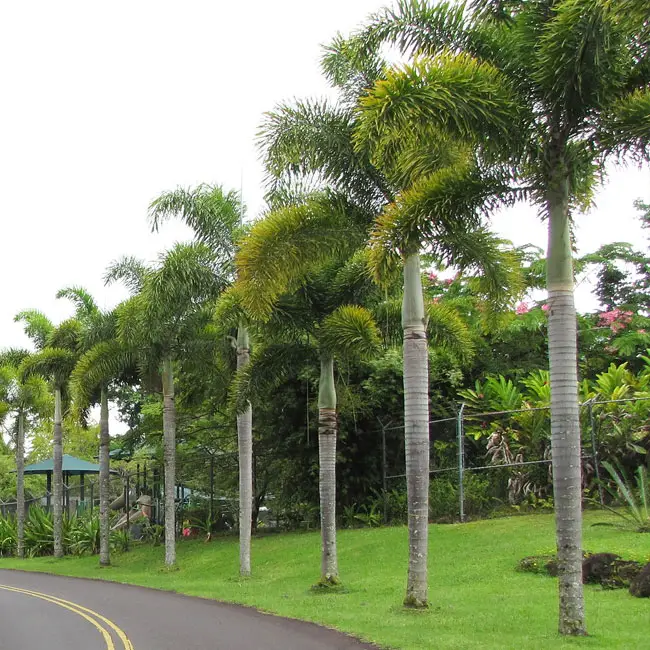
Another popular palm variety worth considering is the Foxtail Palm, scientifically known as Wodyetia bifurcata. This medium-height palm boasts a sleek, self-cleaning trunk adorned with a vibrant green crown shaft, which is crowned by the most exquisite array of feathery fronds, resembling the tail of a fox.
What distinguishes the Foxtail Palm is its suitability for smaller landscapes, as it grows at a moderate pace, typically reaching heights of 25 to 30 feet.
It thrives in full sun, relishing the warmth and easily enduring scorching temperatures up to 100°F. Impressively, it can also withstand cooler weather, resiliently enduring temperatures as low as 30°F and sometimes even dipping into the mid-twenties°F range.
While it’s possible to cultivate Foxtail palms in a container on a patio, it’s important to note that they have a preference for abundant sunlight and aren’t particularly well-suited for indoor growth.
So, if you’re aiming to infuse a touch of elegance into your outdoor landscape, particularly in a sunny location, the Foxtail Palm is an excellent option worth exploring.
4. Royal Palm
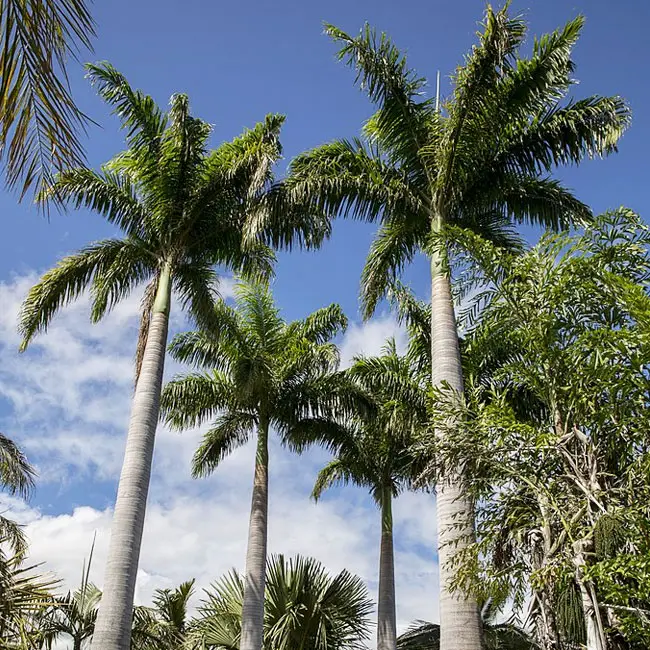
The Royal Palm, scientifically known as Roystonea oleracea, is a native treasure of Florida and South America. This majestic palm stands out with its striking gray, self-cleaning trunk and an elongated, smooth crown shaft from which its feathery fronds gracefully emerge.
While it has the potential to reach towering heights of up to 60 feet, it typically remains more compact when grown in containers.
Yard owners are captivated with this palm not only for its stunning appearance but also for its remarkable resilience in the face of both cold and hot conditions.
Officially, it can withstand temperatures as low as 30°F, but there are instances of Royal Palms in Southern California surviving temperatures below 25°F.
In landscaping, the Royal Palm is a versatile choice. It can be employed to line streets, driveways, or property boundaries. It’s perfect for framing each side of an entry, serving as an architectural accent, or standing proudly as a standalone specimen.
5. Coconut Palm
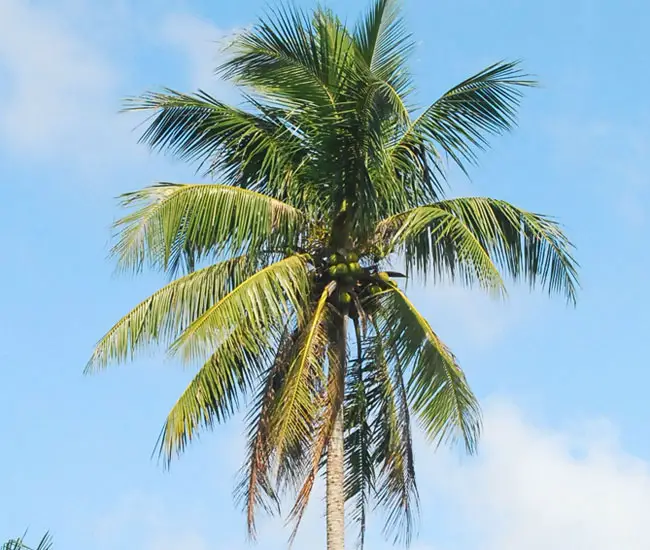
The Coconut Palm, scientifically named Cocos nucifera, ranks among the most globally beloved palm trees. Many cultures rely on its cultivation, utilizing it for food, cosmetics, and lumber. However, it is most renowned for its delectable fruit, the coconut, which it begins producing at around six years of age.
This palm boasts a gracefully smooth, slightly curved gray trunk and arching, feathery leaves. It grows at a moderate rate, typically reaching heights of up to 50 feet. The Coconut Palm exhibits impressive salt tolerance and thrives in sandy soils, making it an ideal choice for coastal areas.
However, it’s worth noting that this palm is not particularly cold-resistant and can only endure temperatures as low as 35°F. Freezing conditions can cause significant damage. For optimal growth, it prefers full sun and well-drained soil.
In landscaping, the Coconut Palm shines as an accent near an entryway, along driveways or fences, as a backdrop for smaller plants, or as a striking standalone specimen.
6. Cabbage Palm
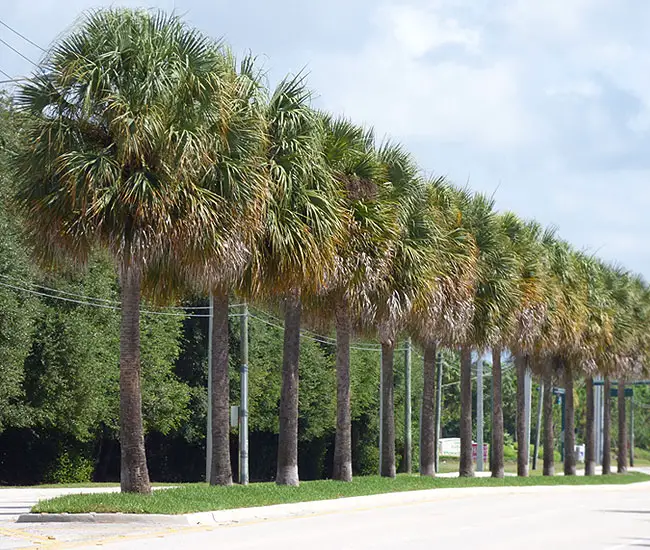
The Cabbage Palm, scientifically named Sabal palmetto, has earned a special place in the hearts of gardeners for its durability and impressive cold tolerance. This robust palm features a substantial, single trunk crowned by a dense canopy of fan-shaped leaves.
It typically grows up to 50 feet in height but may occasionally reach heights of 70 feet. Unlike some palms, the Cabbage Palm lacks a crown shaft, and its leaves emerge directly from the trunk, which gradually sheds old leaf bases, revealing a smooth brown trunk with a distinctive criss-cross pattern.
This palm is not only cold-tolerant but also exhibits remarkable salt and drought resistance. It can endure chilling temperatures as low as 10°F! It thrives in full sun or light shade and is adaptable to various soil types, though it prefers moist, well-drained soil.
In landscaping, the Cabbage Palm excels in lining driveways, freeways, fences, and streets. It can be used either in groups or as a standalone specimen. Its salt tolerance also makes it an excellent choice for coastal areas and beachfront landscapes.
7. Mexican Fan Palm
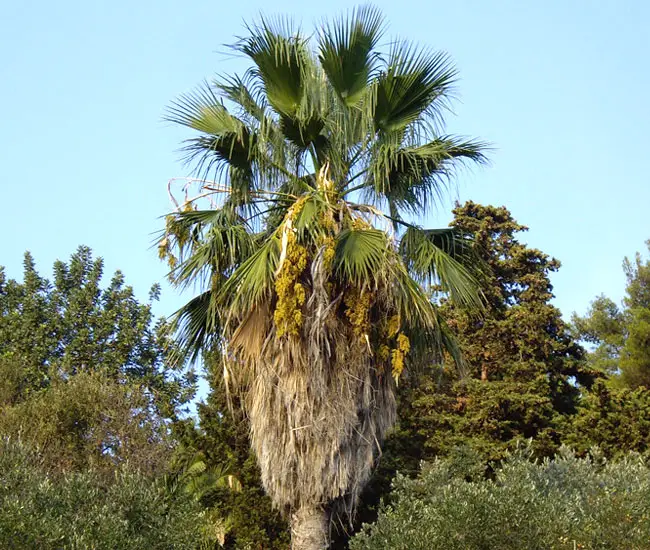
The Mexican Fan Palm, scientifically known as Washingtonia robusta, has gained immense popularity thanks to its striking appearance and impressive durability.
This fast-growing palm has the potential to reach towering heights of up to 100 feet, although it typically tops out at around 60 feet.
In its youth, this palm showcases an alluring massive trunk embellished with red-brown old leaf bases and a thick canopy of fan-shaped fronds.
As it matures, the aging brown leaves create a distinctive, long “hula skirt,” which eventually needs trimming. As these old leaf bases fall away, they reveal a smooth trunk underneath.
The Mexican Fan Palm stands out as one of the hardiest palms, capable of tolerating cold temperatures as low as 10°F. It’s adaptable to a wide range of soils but prefers moderately rich, well-drained soil. While it thrives in full sun, it can also tolerate partial shade.
In landscaping, this palm shines in expansive open areas or when planted at regular intervals along streets. It can also make a striking impact when grouped near tall buildings.
8. Canary Island Date Palm
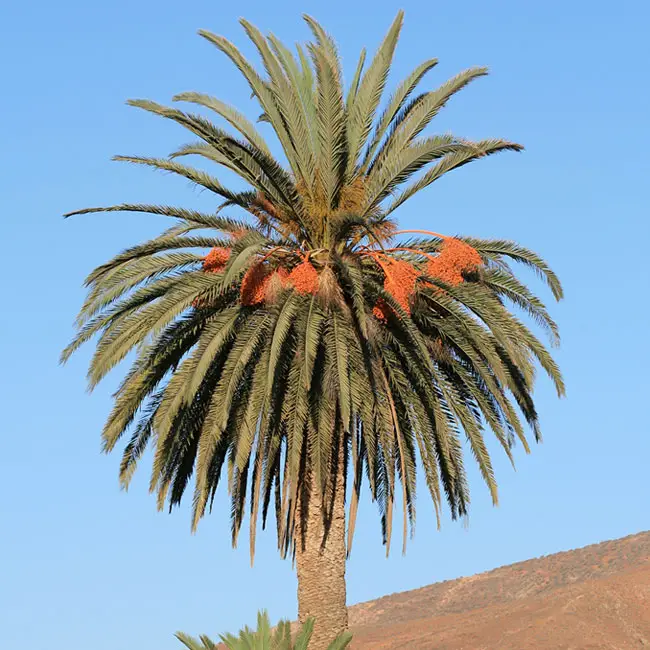
The Canary Island Date Palm, scientifically known as Phoenix canariensis, is a favorite choice for commercial settings due to its impressive size.
However, it may not be the best fit for residential properties due to its massive nature. This palm boasts a dense crown of deep green, feathery leaves that are supported by a large brown trunk covered with diamond-patterned old leaf bases.
In its youth, it exhibits slow growth, which accelerates with age, potentially reaching heights of up to 40 feet, although it’s been known to surpass 60 feet.
The Canary Island Date Palm is cold-hardy and can endure temperatures as low as 15°F. It thrives in full sun and well-drained soil.
In landscaping, this palm makes a grand statement, making it suitable for parks, campuses, boulevards, highways, or as a focal point in cityscapes.
However, it’s most appropriate for large properties, as it has sharp teeth on the stems that can pose a challenge when planted near walkways.
9. Christmas Palm
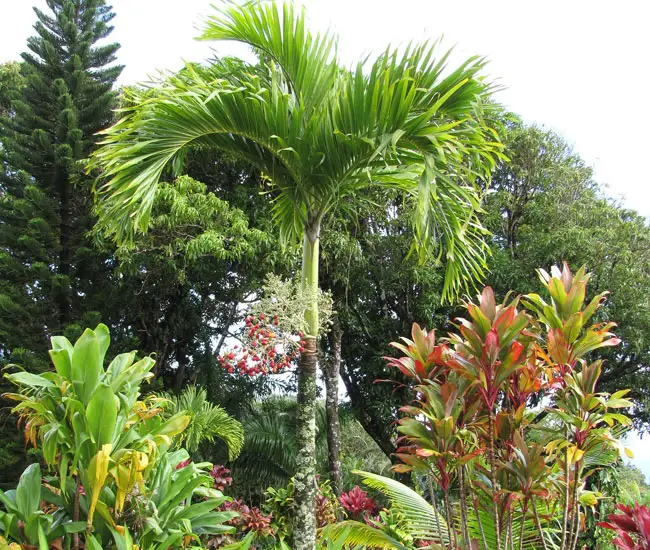
The Christmas Palm, scientifically known as Veitchia merrillii or Adonidia merrillii, ranks among Florida’s most popular palms, prized for its captivating appearance and ease of maintenance.
It features a slender grey trunk adorned with distinctive leaf scar rings and graceful, arching fronds emerging from a green crown shaft. This palm earned its common name, the Christmas Palm, because of its bright red fruits that resemble Christmas ornaments.
In terms of size, it typically grows to a height of about 12 to 20 feet but remains much smaller when grown indoors.
The Christmas Palm thrives in full sun and well-drained, moist soil. It can tolerate some salt and brief periods of drought. However, it’s not considered cold-hardy and can only withstand temperatures down to 35°F.
Due to its compact size, the Christmas Palm is an excellent choice for small-scale planting. It looks particularly charming when planted in groups of two or three and can be used by the house entrance or poolside to provide much-needed shade.
10. Fishtail Palm
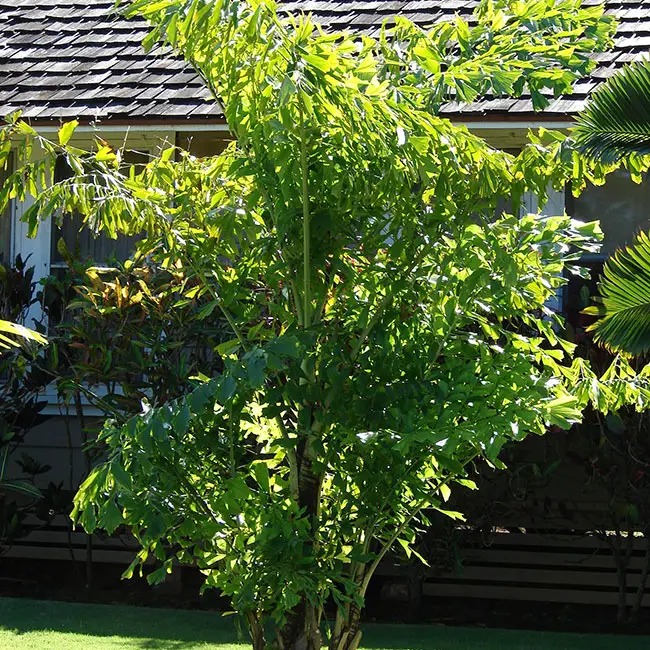
The Fishtail Palm, scientifically known as Caryota mitis, is a dense, clustering palm that excels at creating privacy walls. Gardeners appreciate it for its low maintenance requirements and affordability.
It features slender stems crowned with feathery fronds, with green leaflets that bear a unique resemblance to a fish’s tail fin, hence its name. This palm grows at a moderate rate, reaching heights of up to 15 feet.
The Fishtail Palm thrives in full sun and well-drained, moist soil. It can tolerate temperatures as low as 35°F and is even known to survive light frosts.
Because it can handle significant shade, it’s a suitable choice for indoor cultivation as a container plant. Outdoors, it serves admirably as a shrub border, fence lining, backdrop for other tropical plants, privacy screen, or as an accent in the corner of your house.
Related articles:
–Palm Tree Care 101: Ultimate Guide to Health & Happy Palms
–10 Most Popular Fast Growing Palm Trees (with Pictures)
–20 Amazing Palm Tree Landscape Design Ideas (with Pictures)
–Top 35 Types of Palm Trees (with Pictures)

I have a cluster palm that is 40 years old and 30′ tall. It was recently pruned to it’s itended look. I was told it was a Robellini Palm, but it is too big! All I can find online are palms with fanned fronds. Mine are elongated to a point. Can you tell me anything about this type and care requirements. And value!. And how I can send you before and after pics
I have a palm tree and was trying to figure out the name of it I would proud if u could help
Please let me know the name of palm trees that are easily grow in Asian humid environment.
Would you identify a palm tree growing in the garden of the home I recently purchased? If you send me an email I’ll reply with a photo. (Can’t figure out how to paste or embed in this comment section.) Thanks.
Meditarranean date palm the lower leaves are turning brown is that to much water am I to stop watreing ,
I have five royal palms and ten eureka palms on my property plus two hundred christmas palms in pots.
We live in the 77971 area in Lolita TX on the gulf Coast.
I saw on facebook recently there was a dog that almost died eating a palm tree ‘seed’.
Please tell me which palm trees I sound not have around my dogs and horses.
Thank you!
I enjoyed Your pictuers of palm trees. I have four royal palms, six bottle palm and six eureka palms. I love them. thank you very much.
I would like to growing a Medjool Dattes Palm tree in Florida do you advice me
I am trying to figure out if the palm trees on my community property are poisonous for my dog. I live at Colonial Grand at Hampton preserve
I recently purchased a house in Boynton Bech Florida. I have a palm tree with fan shaped leaves and 11 trunks. i don’t know the name of it but its too large for the size of the property. i am curious to know if some of the trunks can be cut off without damaging the tree. i can send you photos if it will help identify it.
Lynn Sauer
We purchased a home in Tampa, Florida with 3 palm trees 2-3 from the house…which gives us concern about possible future home damage.
They are about 20′ tall, have oval black seed clusters, which the squirrels have decimated leaving the seeds all over the ground.
I have not been able to ID them from the internet and wondered if you could. I would need an email address to forward a picture, if that is acceptable.
Thank you for any assistance . . .
I live in Gainesville, Ga. Some hardiness maps show me as 8a and some show me as 7b. Can you help?
Is it possible to move a safe palm to another area,as it is getting too big for area it’s in.I was told they have short root system .
We purchased a home a year ago in Naples, FL. There is a very nice Sago Palm at the entrance to our front door. We noticed the bottom of the bottom rows of fronds are covered in white. The new top fronds are very healthy looking with no white on the bottom of the fronds.. Does anyone know what this white area is? It looks as if it may be diseased with aphids, or some type of scale, etc. We don’t want to lose this lovely palm tree. Thanks for any help you can give.
I live in central Florida and want a palm tree in my front lawn. Nothing too big but 15 – 20 feet, and pet friendly. Any suggestions would be appreciated. Temps dont go below 30° f. Lawn is not big maybe 30 x 30
We have a 20 year old Pinto palm and after the last Hurricane Florence the spiked limbs (what ever they are called) have started dropping off on one side. It has still put out greenery but not as large as before. Just not sure if it has reached it’s life expectancy or if it can live longer…What can be done for it. Should we just cut it down?